Have you decided to start your herbal tea garden? Many herbs can be dried or used fresh to make herbal teas (sometimes known as tisanes) and enjoyed on their own…but not all of them taste that great.
This guide will help you with herbal tea blends that have full and unique flavors.
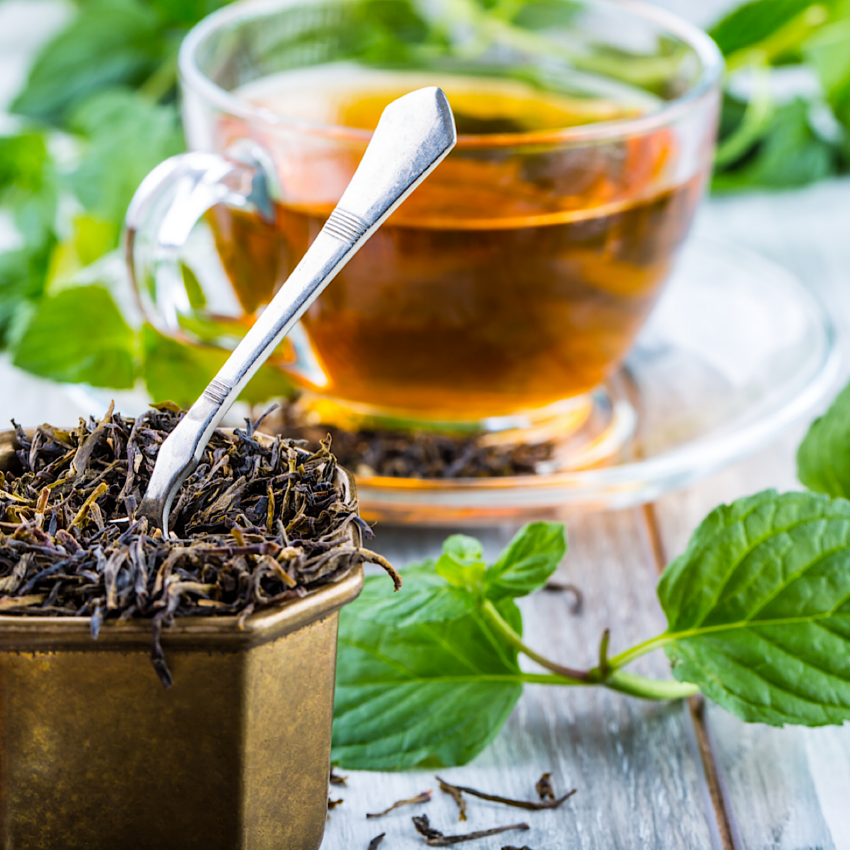
This post may contain affiliate links, and you can read our disclosure information here–
Jump to: 9 Herbal Tea Blend Recipes | Blending Formula
Some herbal teas have well-tested health benefits but a weak flavor, needing a little help. No worries: that’s why you blend, blend, blend.
Mixing herbs to make tasty combinations is a bit of an art, but you’ll get a feel for which flavors go together soon enough.
In this tea blending guide, let’s go into a few handy tips and tricks, as well as 9 of my own favorite herbal tea recipes.
What Do You Need to Blend Your Herbal Tea?
Making your herbal tea blends is super easy if you have a few types of herbs on hand.
Many commercial blends contain artificial ingredients and even sweeteners. They can also be quite old and stale, or made with low-grade tea.
Going the DIY route is usually more natural (and more fun too!).
All you’ll need is:
- Glass jars
- Labels
- Tea strainer
- Your herbs of choice
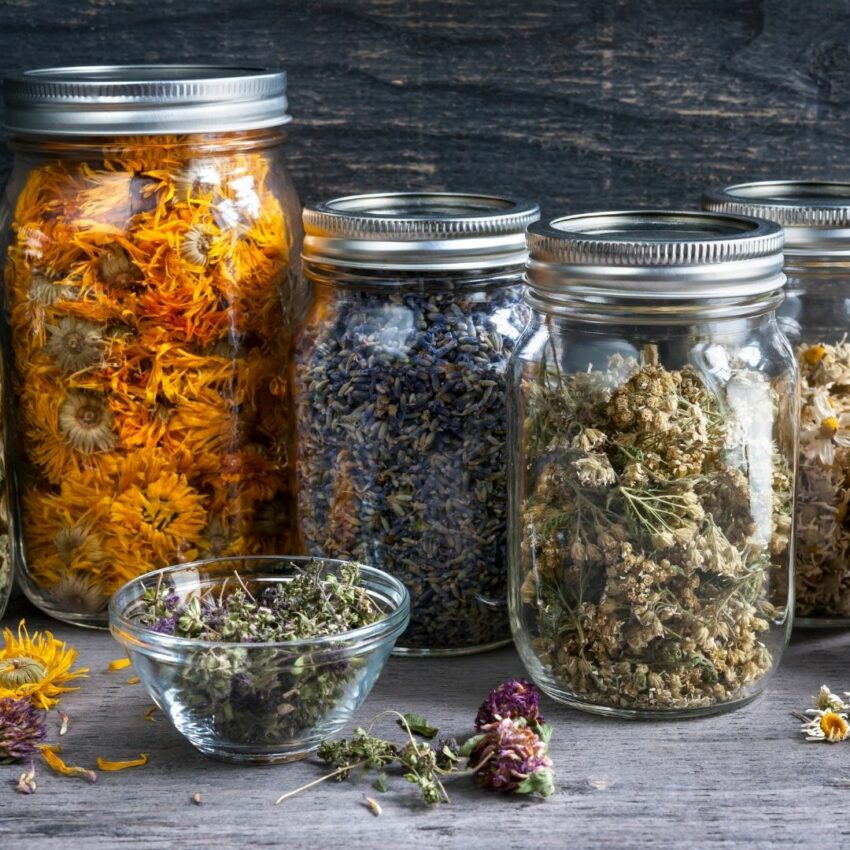
After mixing, you can store your blends in the jars, making sure to seal them well. Keep in a dry and dark place for up to a year; your herbal tea won’t go bad after that, but the flavors may become less intense.
You could spruce them up with a slice of fresh lemon or ginger if this happens and you don’t want to just toss them.
By the way, if your tea garden doesn’t yield all the herbs you like in your brews, there are plenty of places online and offline that sell (dried) herbs in bulk.
And don’t forget, although we call them herbal teas, they don’t technically only need to contain herbs. Many common whole spices, like cinnamon, cardamom, ginger, and the like are also easy enough to find, maybe even in your cupboard. The same goes for flavor bombs like citrus peel.
Basic Formula for Herbal Tea Blends:
I’ll list some tea-blending recipes below, but in case you want to explore creating your own combinations, try following the base + star ingredient + accent formula from the chart below “Blending Herbal Teas”.

Mellow Base Ingredients:
- chamomile
- (pepper)mint
- lemon balm
- linden flowers
- yerba mate
- nettle
- raspberry leaf
- holy basil
- rooibos or actual real tea.
Stronger Star Ingredients:
- Roots: licorice, chicory, dandelion, ginger
- Flowers: elderflower, hibiscus, chocolate mint, lemon verbena
Very Strong Ingredients to Add an Accent Flavor:
- citrus peel (citrus)
- cinnamon (warm)
- rosehip (floral & tangy)
- ginger (spicy)
- cardamom (warm)
- lavender (floral)
- fennel seed (licorice)
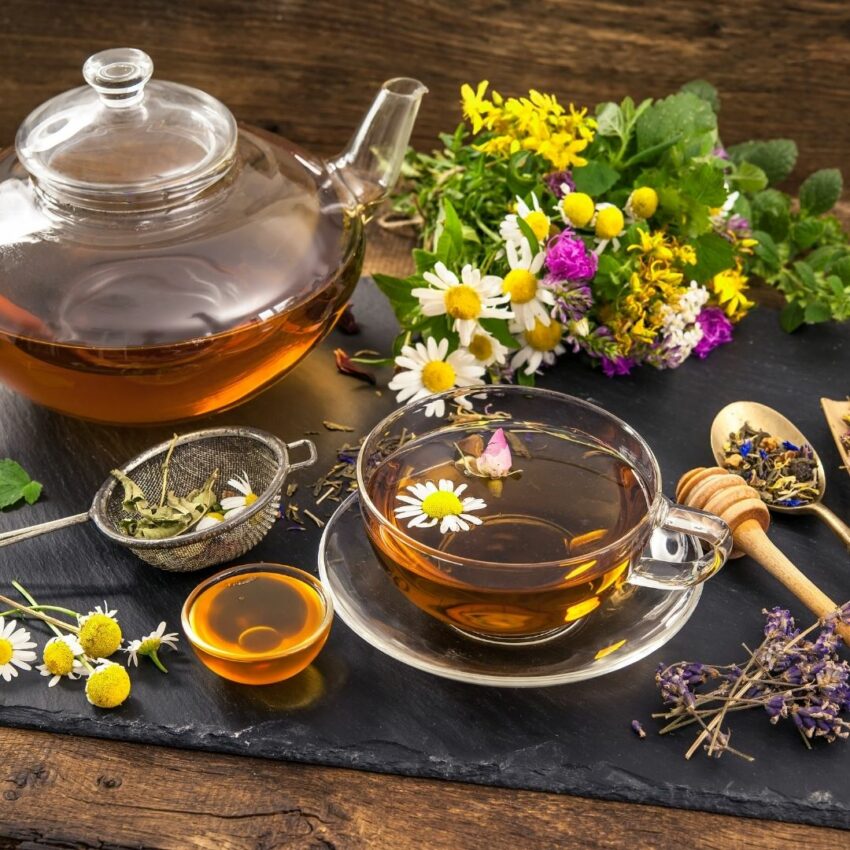
Key Flavor Profiles when Blending Teas and Tisanes
There are too many herbs and spices available that you can include in your blend for me to even try to begin listing them all, but these are some of the more popular flavors:
If you’re not sure about an ingredient’s flavor, you can always make a solo tea with it as a little introduction.
Citrusy Flavors:
- lemon balm
- lemon verbena
- lemon peel
- orange peel
- lemongrass
- lemon thyme
Minty Flavors:
- mint
- spearmint
- peppermint
- catnip
- bee balm
Floral Flavors:
- chamomile
- hibiscus
- rosehip
- rose petals
- lavender
- elderflower
Warm and Spiced Flavors:
- turmeric
- cinnamon
- cardamom
- ginger
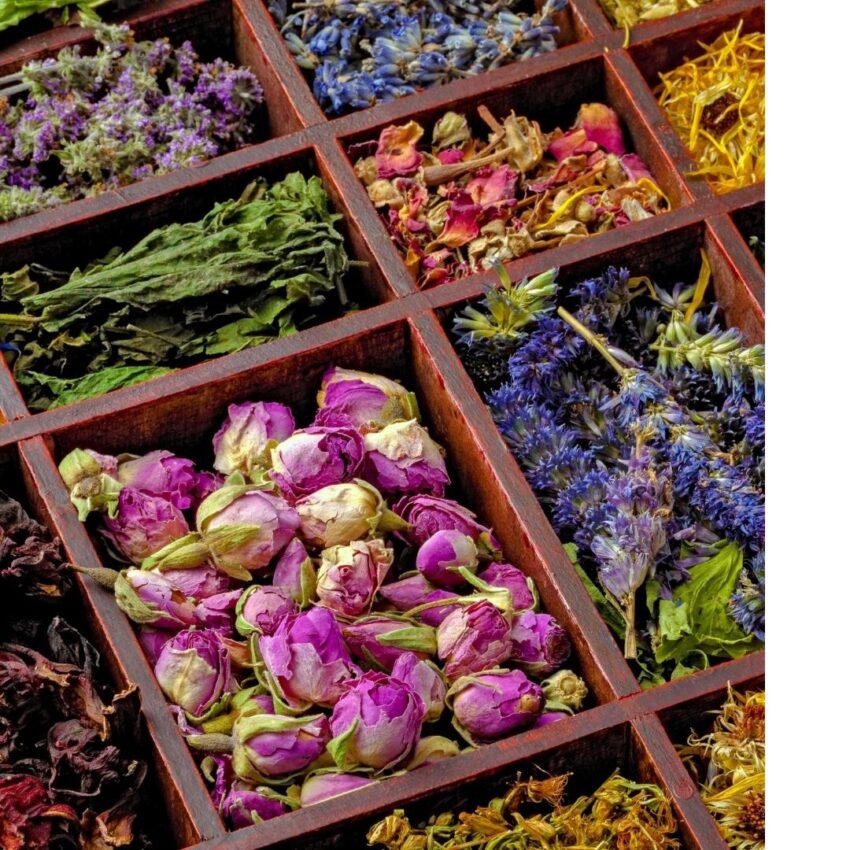
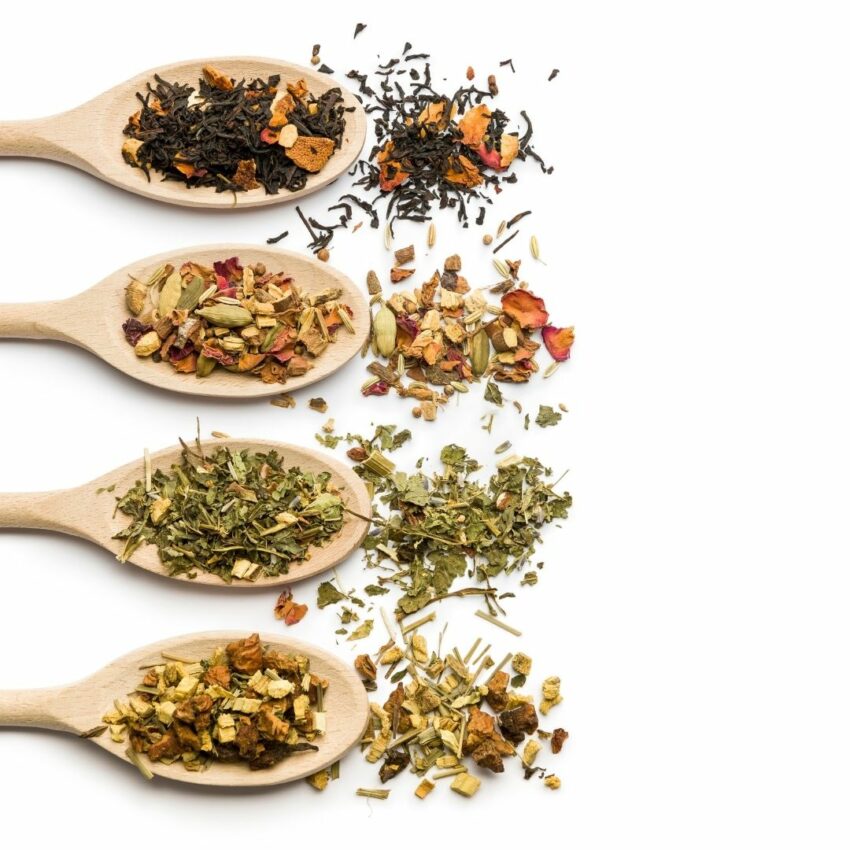
Best 9 Herbal Combinations for Tea (+ Food Pairings)
After all this talk about tea blending techniques, you’re probably ready to move on to the actual brewing part. I’ve gathered a few of my personal favorite herbal tea blend recipes here.
As a rule of thumb, you’ll want to use 1 teaspoon of tea blend for every cup of boiling water. Steep herbal teas longer than black teas. You may need to steep up to 10 minutes to extract full flavor.
For a really strong flavor, you can boil the ingredients in water for a few minutes, but beware that it can result in a bitter sensation.
Black teas go with hearty dishes, green teas go with light dishes, white teas are for very neutral foods like white fish… and herbal teas are considered to be healing teas for a number of ailments, but they tend to go particularly well with desserts.
I’ll include some food pairing suggestions with the homemade herbal blends below.
Did you know? Tea and food pairing is considered a bit of a fine art similar to wine and food pairing. And yes, tea sommeliers exist!
Floral Tea Ingredients:
- 2 teaspoons dried chamomile flowers (base)
- 2 teaspoons dried rose petals (star)
- 1 teaspoon dried lavender buds (accent)
Pairs well with: tart, citrus-based desserts like my faux Meyer Lemon Pie.
Citrus Tea Ingredients:
- 3 teaspoons dried lemon verbena (base)
- 2 teaspoons dried bee balm leaves (star)
- 1 teaspoon dried lemongrass (accent)
- 1/2 teaspoon dried orange peel (accent)
Pairs well with: something sweet and fruity to balance out the tea’s tartness, like strawberry tiramisu.
Mint Tea Ingredients:
- 4 teaspoons dried mint leaves (base)
- 1 teaspoon dried rose geranium leaves (accent)
Pairs well with: chocolate, of course! Try it with chocolate espresso quick bread.
Herbal Iced Tea Ingredients:
- 6 teaspoons dried mint leaves (base)
- 3 teaspoons dried pineapple sage leaves (star)
- 1 teaspoon dried hibiscus leaves (accent)
Pairs well with most summer dishes. Try it with squash blossoms, radish-cream cheese appetizers, or low-carb beef sliders.
Sleepy Time Tea Ingredients:
- 4 teaspoons dried lemon balm leaves (base)
- 2 teaspoons dried chamomile leaves (base)
- 1 teaspoon dried valerian root (star)
- 1/2 teaspoon dried lavender flower (accent)
Pairs well with: if you’re taking it to help you sleep, you may want to have this one on its own.
Mediterranean Tea Ingredients:
- 3 teaspoons dried mint leaves (base)
- 1 teaspoon dried rosemary (star)
- 1 teaspoon dried thyme (star)
- 1/2 teaspoon dried lemon peel (accent)
Pairs well with: anything Mediterranean such as this roasted harissa chickpea snack
Warming Tea Ingredients:
- 4 teaspoons dried holy basil (base)
- 1 teaspoon dried ginger (star)
- 1 teaspoon dried cardamom (star)
- 1/2 teaspoon dried lemon peel (accent)
- 1/2 cinnamon stick (accent)
Pairs well with: this Pumpkin Amaretto quick bread for a very complimentary combination.
Immune Booster Tea Ingredients:
- 4 teaspoons dried nettle leaf OR dried holy basil OR half-half (base)
- 1 teaspoon dried Echinacea flower (star)
- 1 teaspoon dried ginger (star)
- 1/2 teaspoon dried rosehip (accent)
Fresh Herbal Tea Ingredients:
- 1 sprig fresh mint (base)
- 2 slices of fresh ginger root (star)
- 1 sprig of fresh rosemary (star)
- 1 slice of lemon (accent)
- Optional: 1 slice of orange
Simmer this mixture for 5 minutes on low heat and then let it sit for 5 more.
Psst: If you would rather purchase herbal teas that have already been blended with organic ingredients from our farm, take a look at some of our premium tea blends. .
Frequently Asked Questions:
Sure! Almost all of the popular herbs used in teas are absolutely fine and have the same health benefits for kids.
There are a few plants that aren’t safe, so if you’re thinking of making a brew with a more “obscure” species, just do some research to make sure. Healthline’s herbal tea for toddlers post is a good reference starting point.
Nope! Tisanes that don’t contain Camellia sinensis (the tea plant) don’t have caffeine, so you can drink them whenever. The only exception would be if you used yerba mate in your blend.
If you like my articles about cooking and gardening, subscribe to my weekly newsletter, where I share free recipes and gardening tutorials.

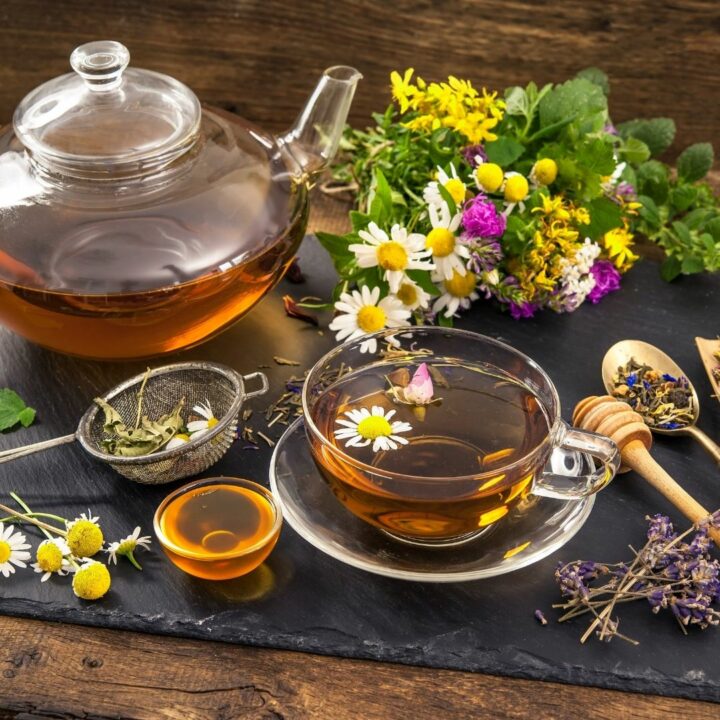
Thank you for helping me expand my teas 💖 I love this 💖
Does anyone use dried Saffron Crocus PETALS in the tea blends?
@Shalane, I understand those are toxic. We live near a couple of saffron farms and though they use them sometimes for cosmetics, soaps etc, consuming them is not recommended!
Saffron is used in cooking the world over and has been used safely for centuries. Not sure what you are referring to….any sources? Saffron is available in most grocery stores and although expensive it is ubiquitous in cooking.
I have never seen these available to purchase. Maybe someone else on the site can answer?
This is so helpful, thank you!
Thank you for commenting! So glad you found it helpful!
Love teas herbal favorite
I’m there with you Juanita. I’ve switched up my coffee habit this Winter to tea and it’s so much more comforting!